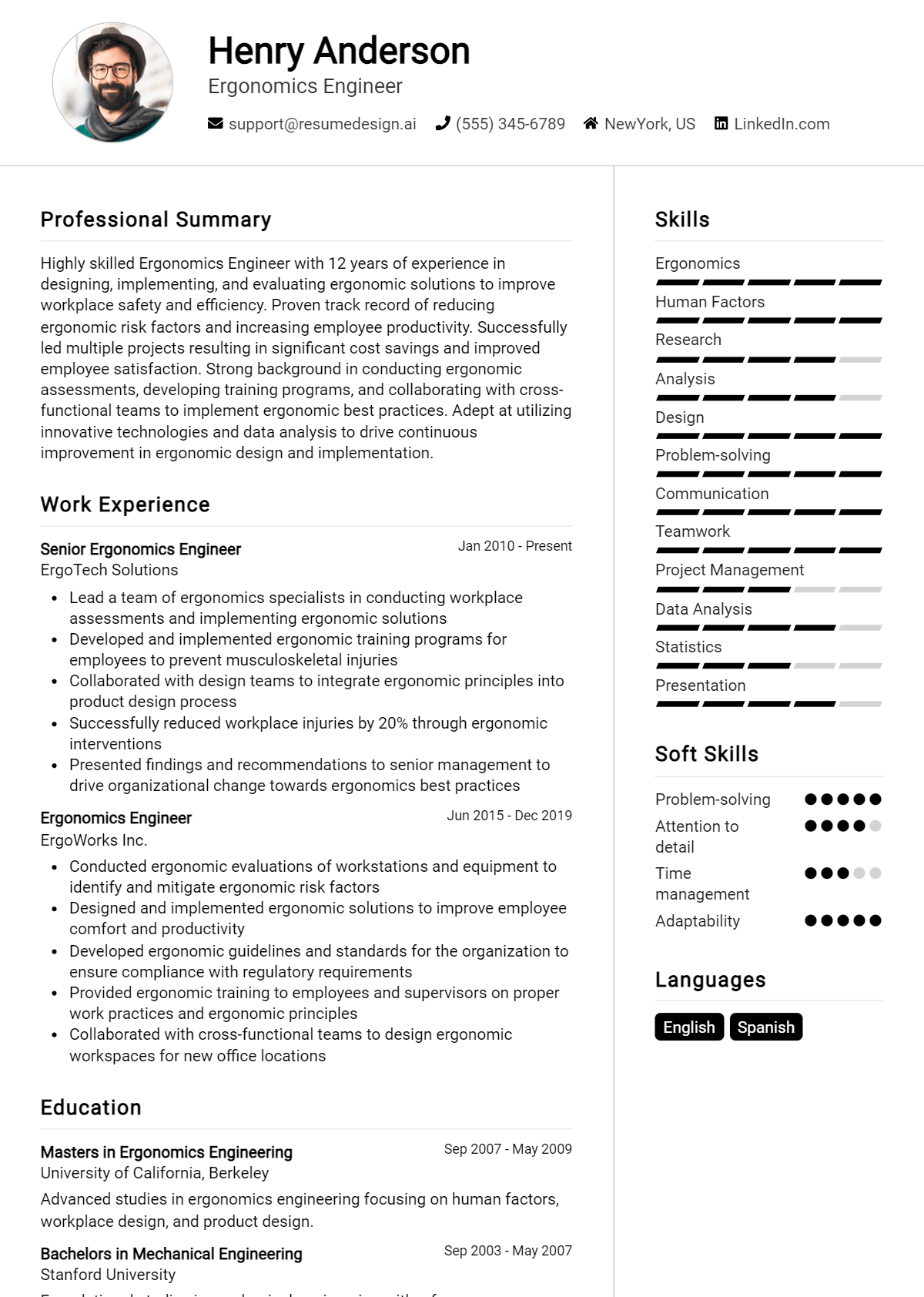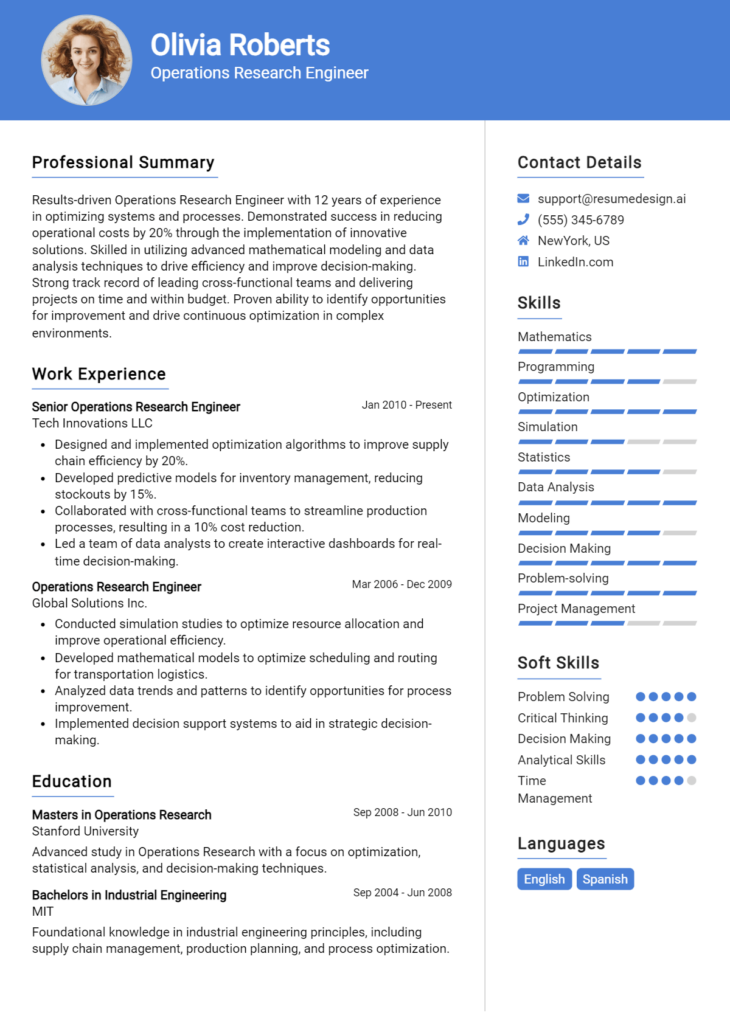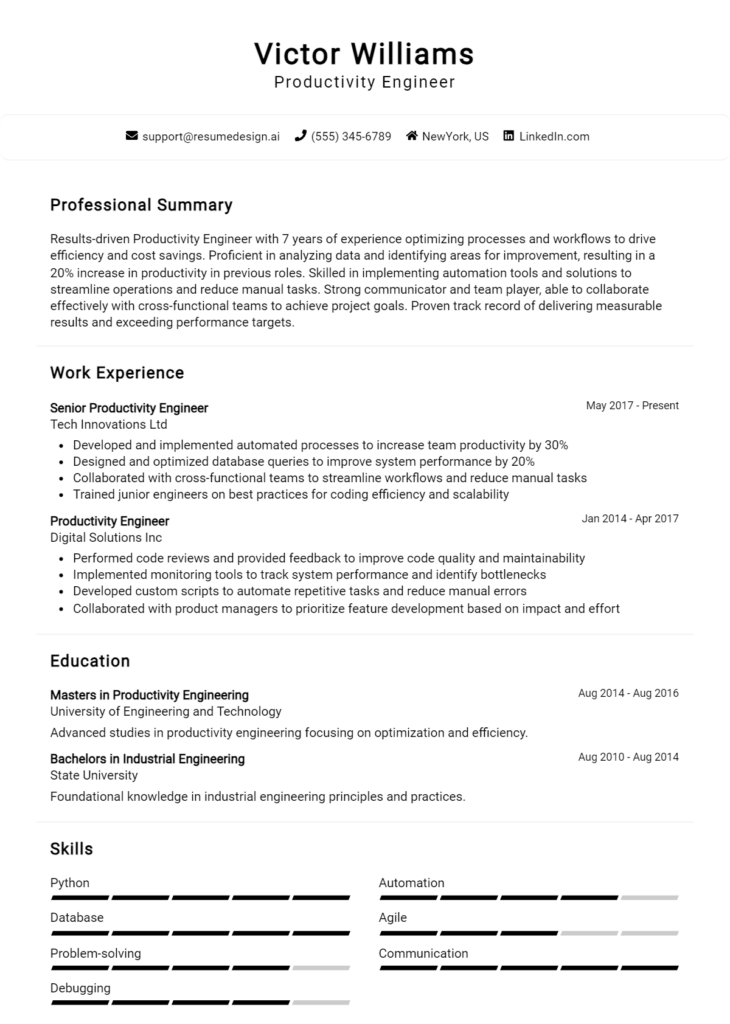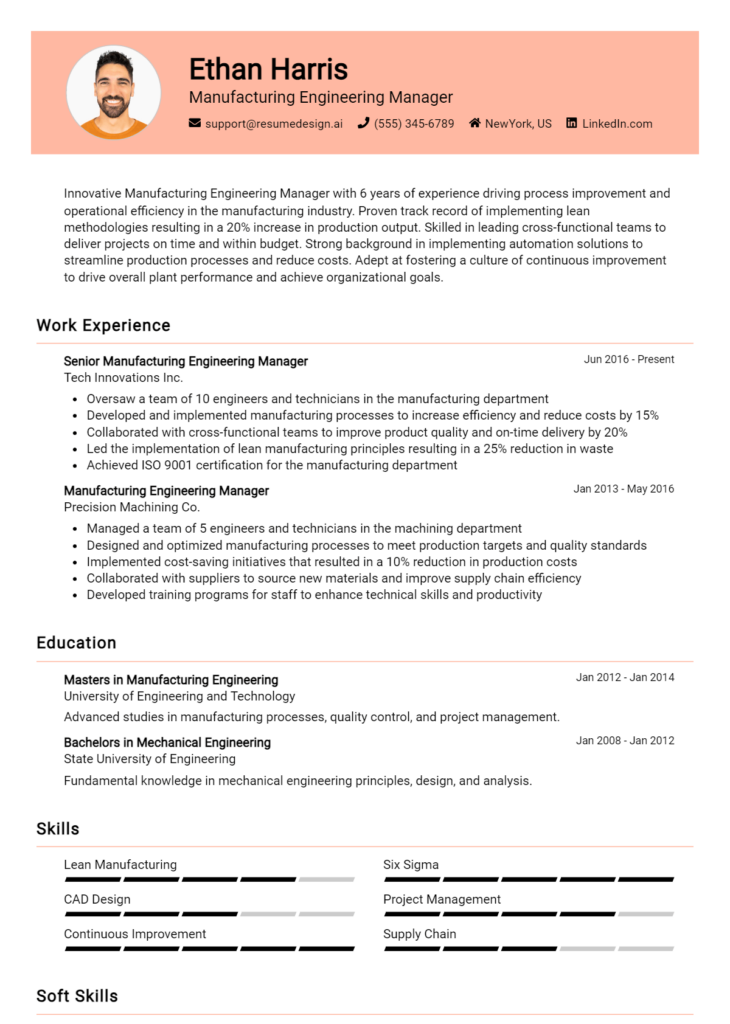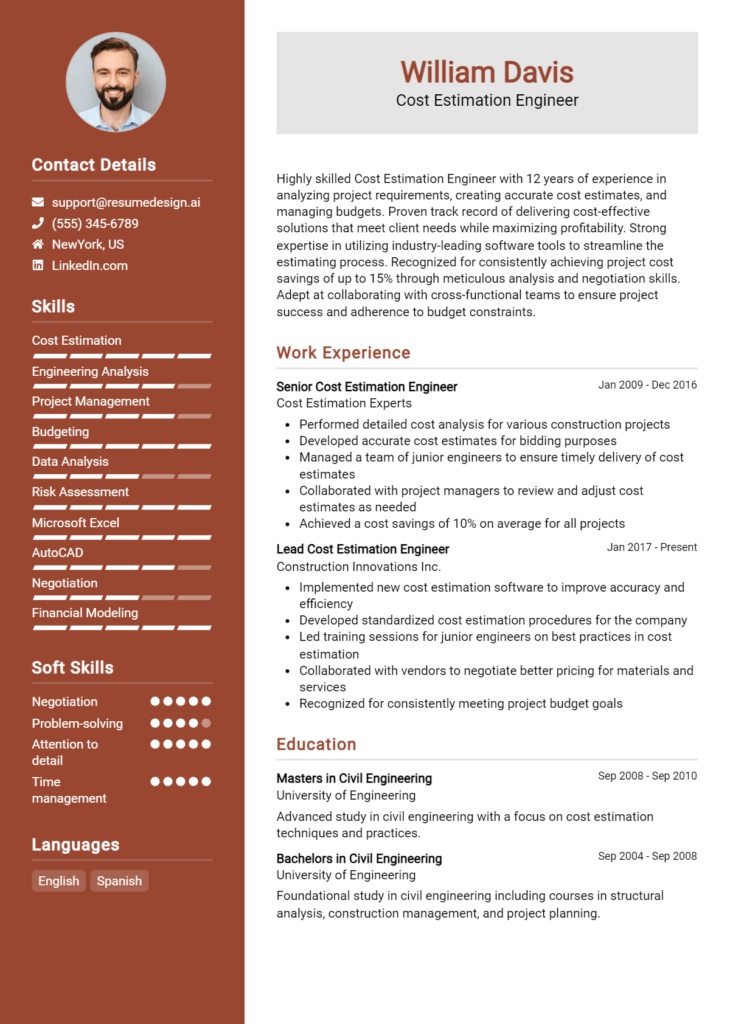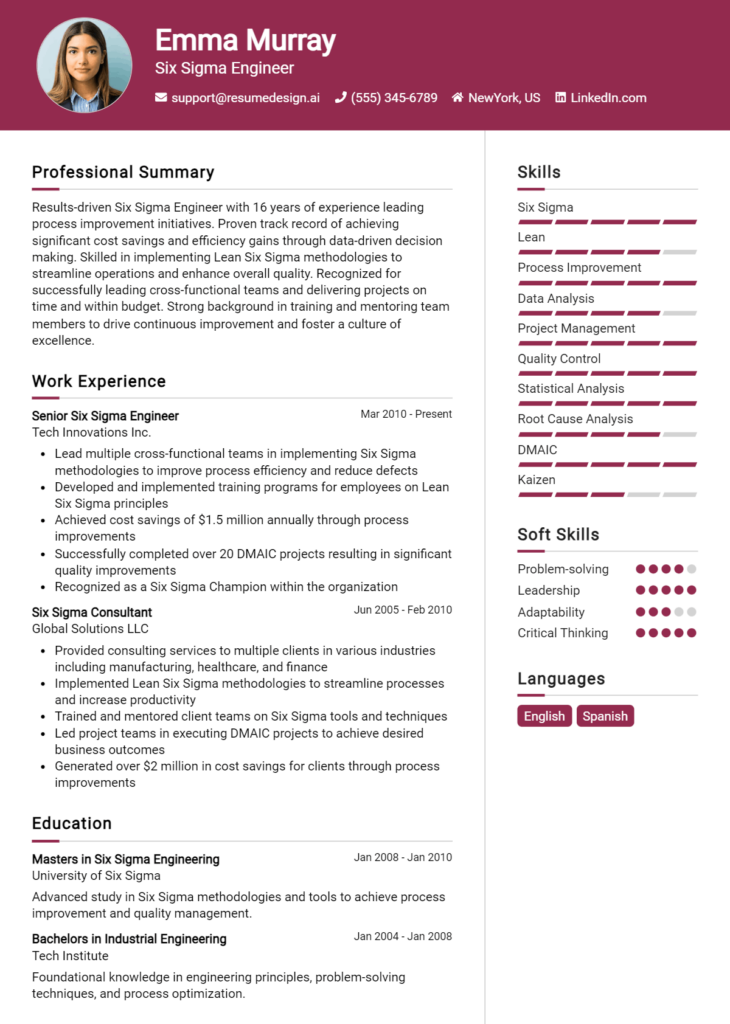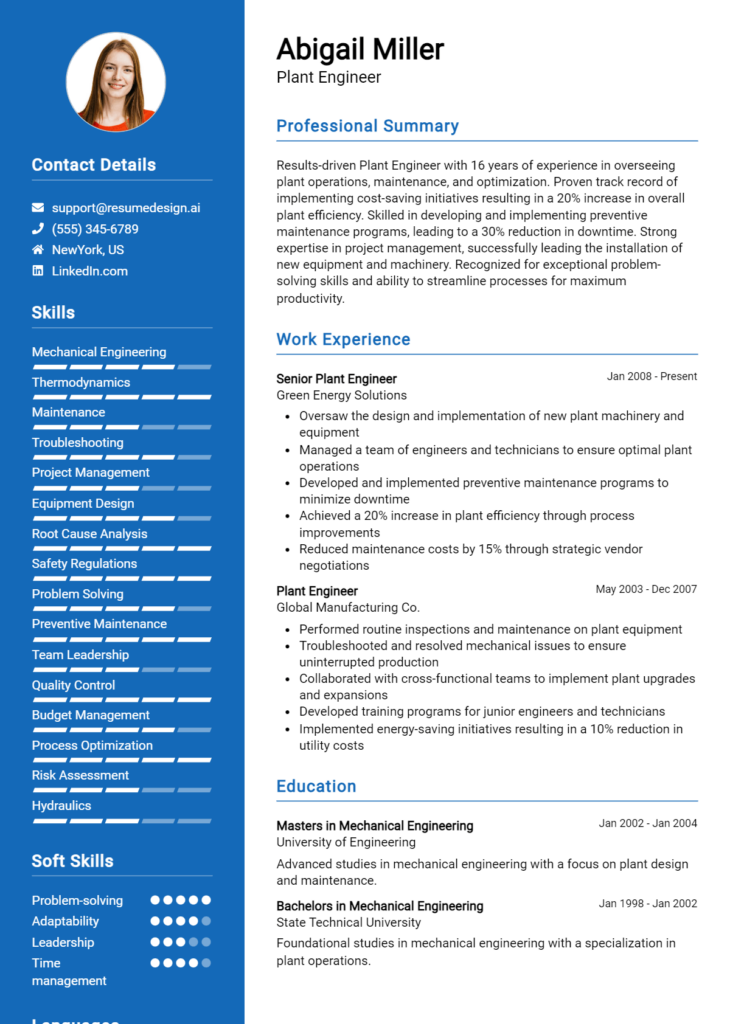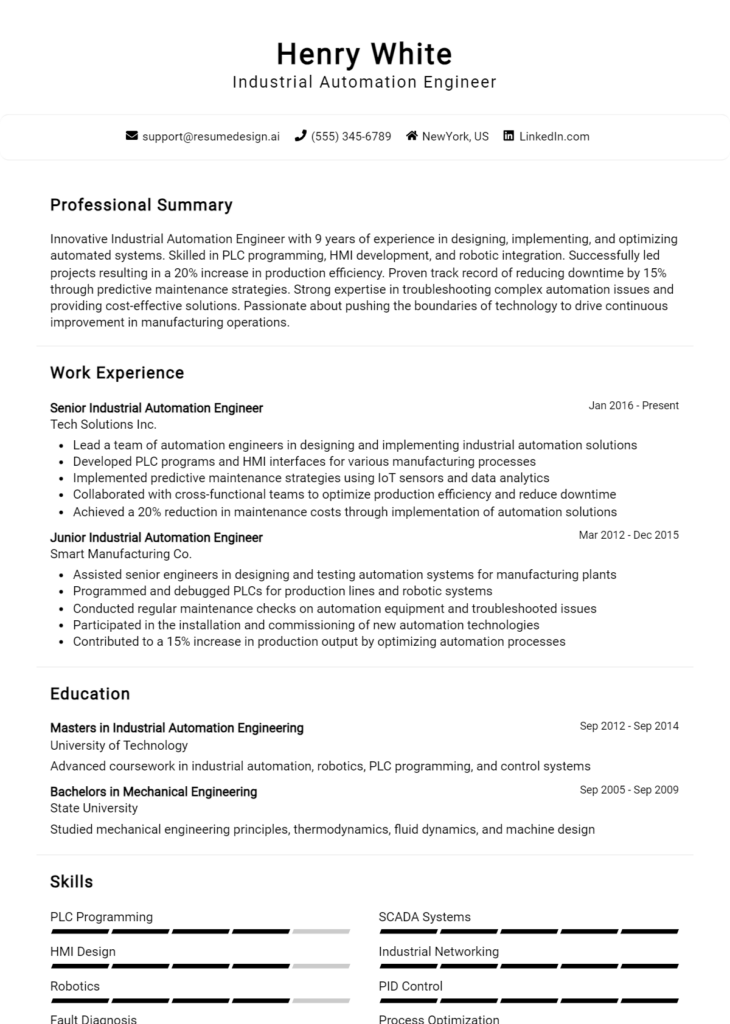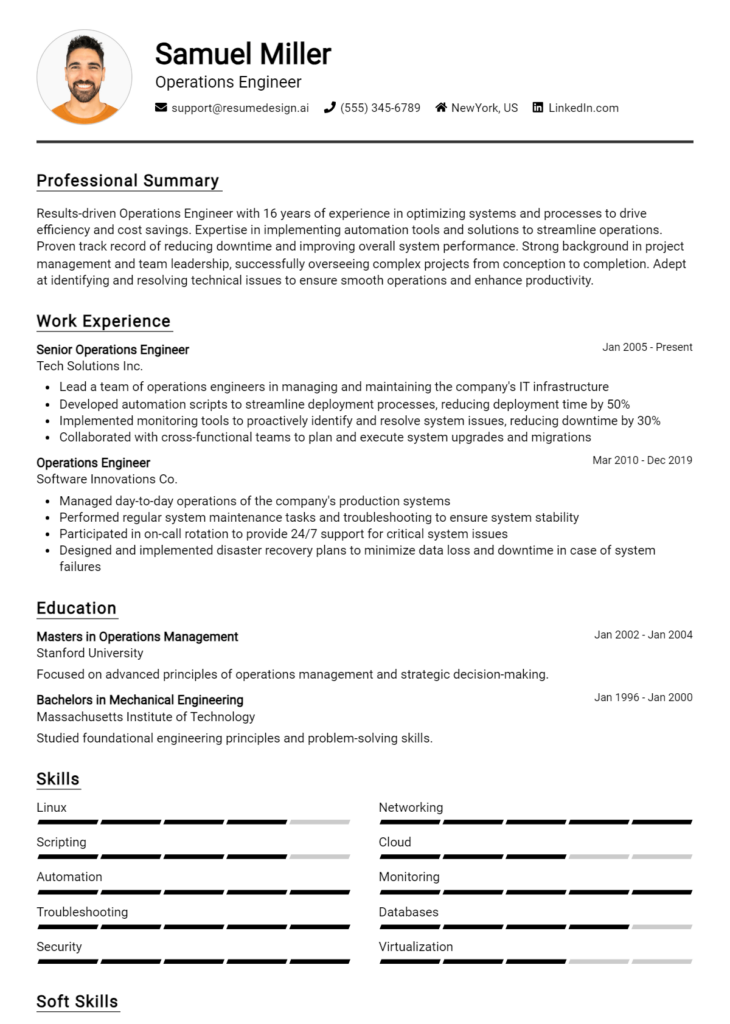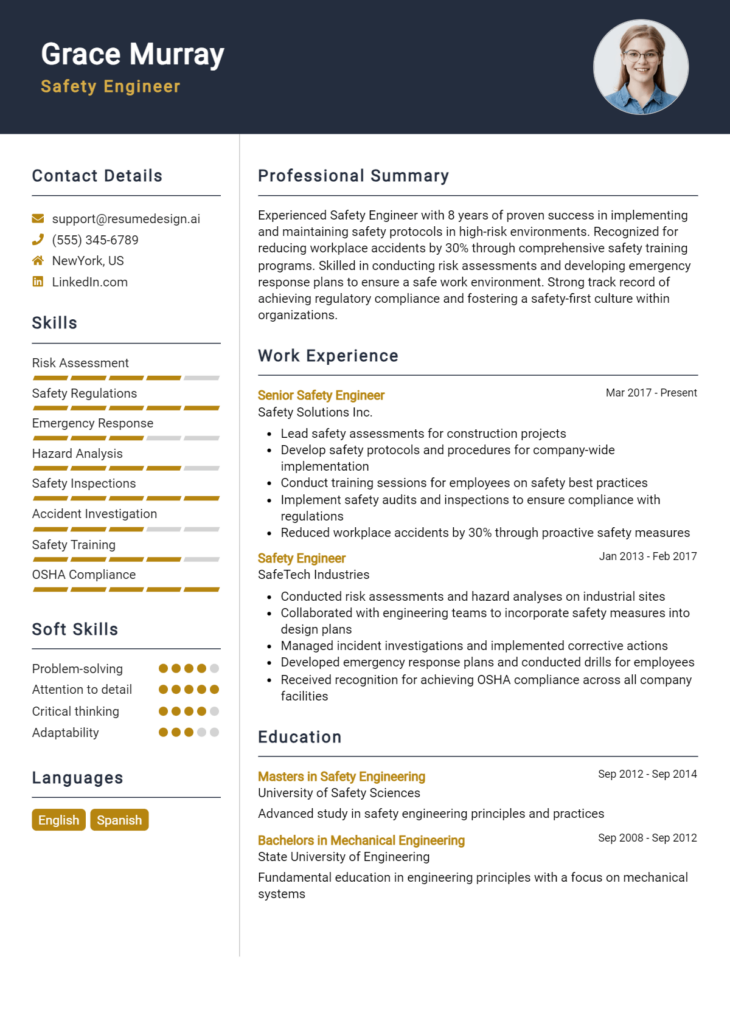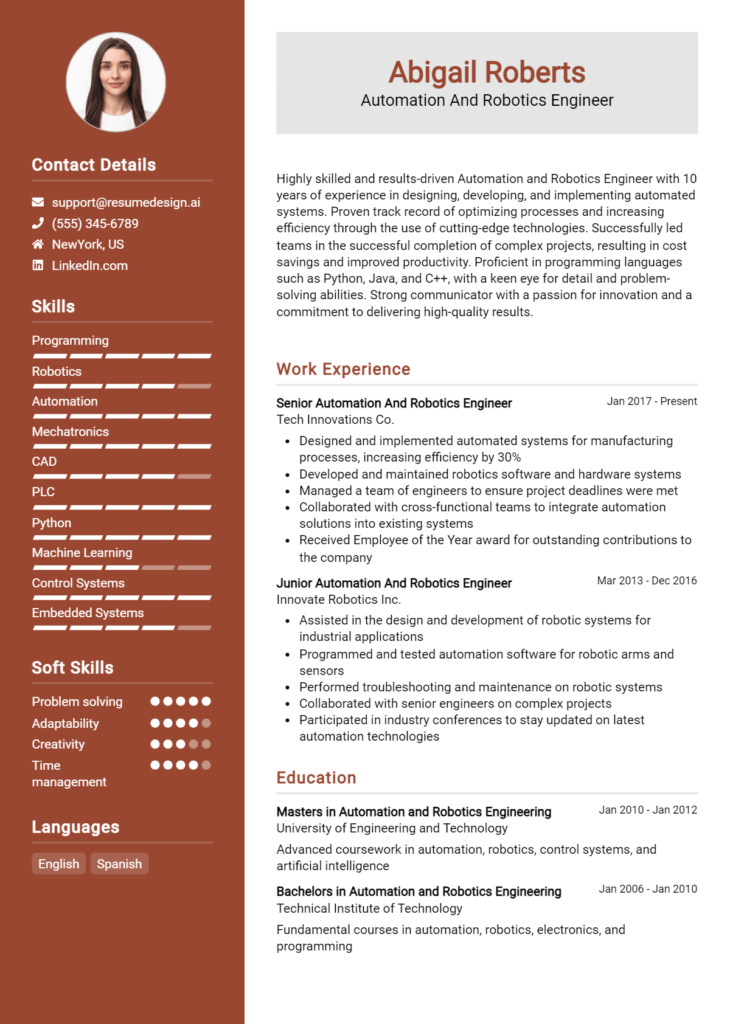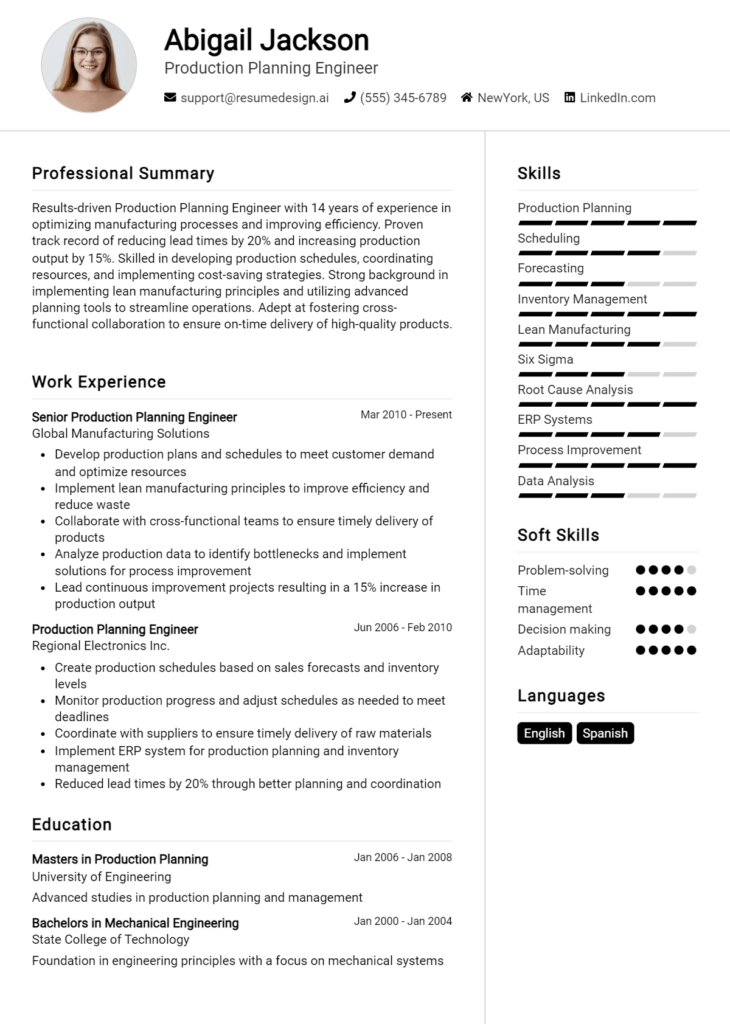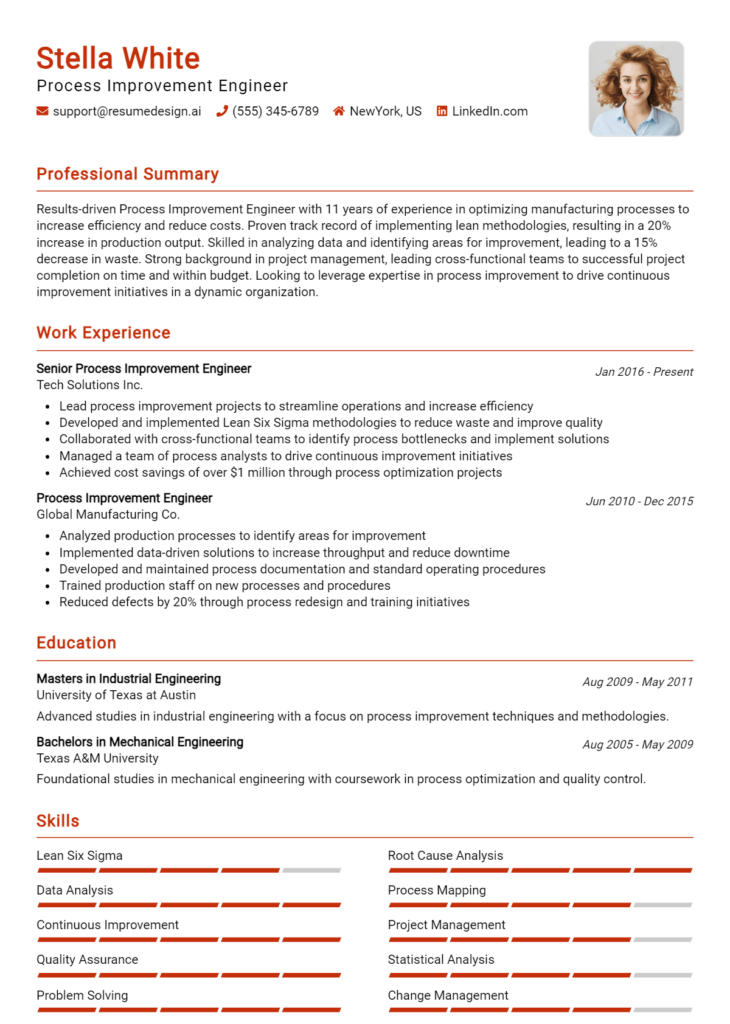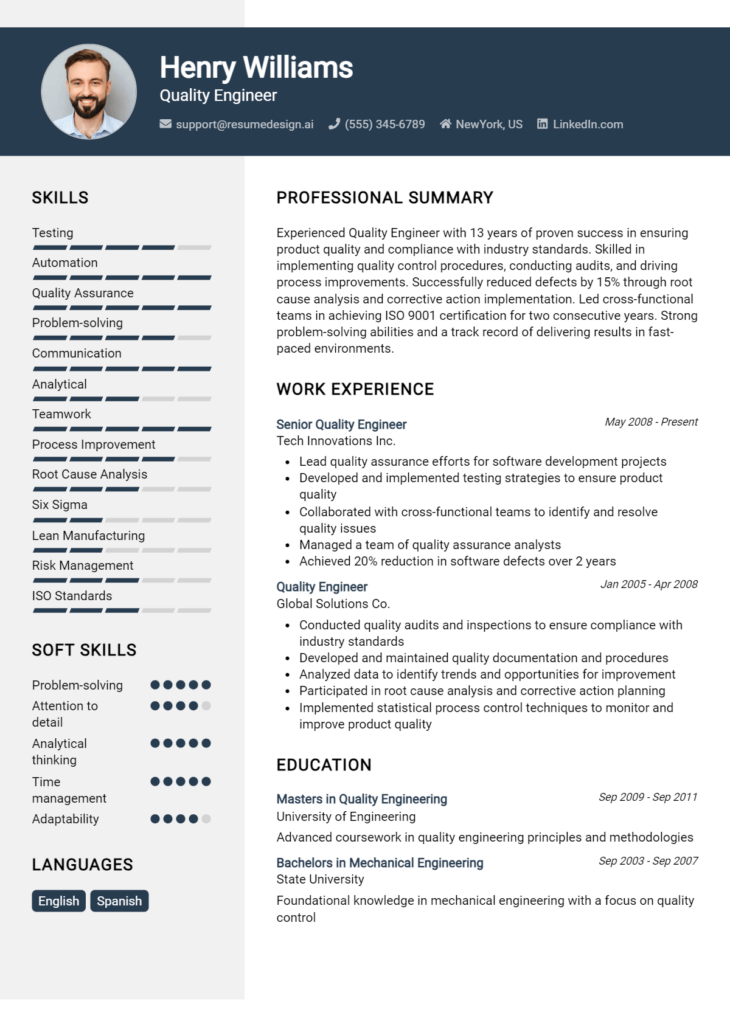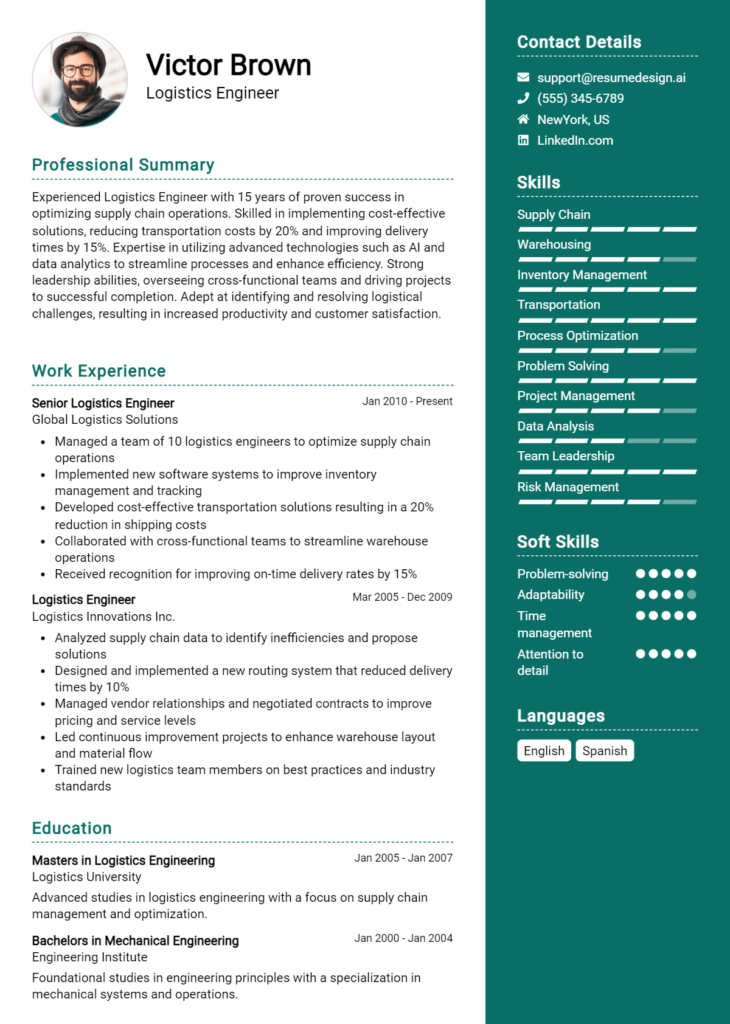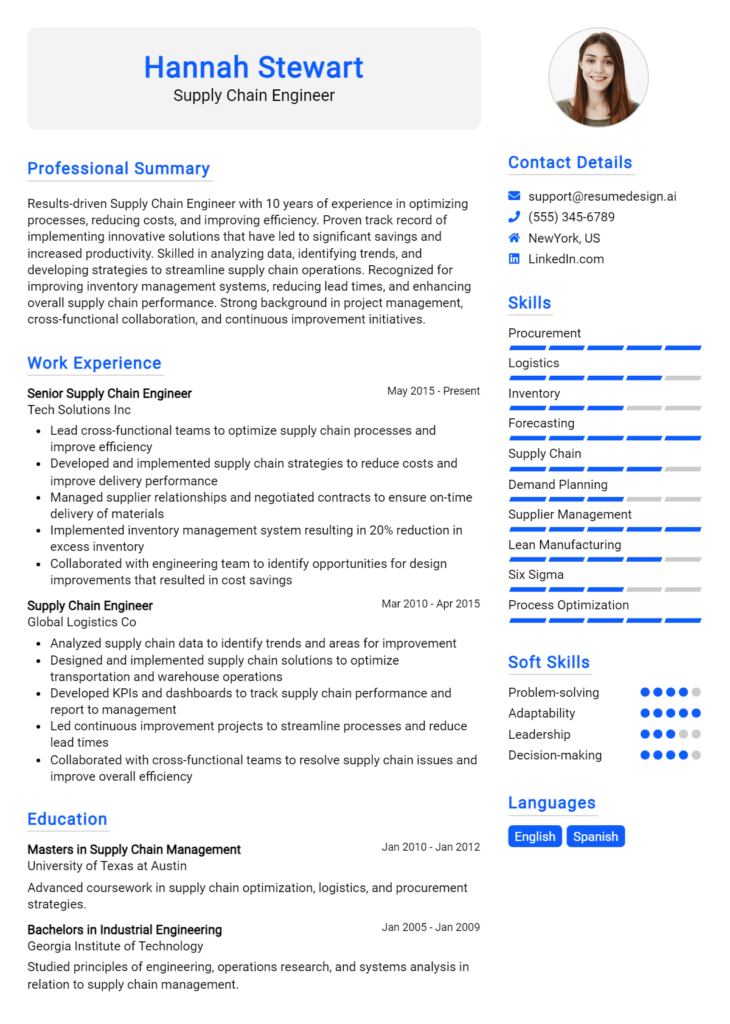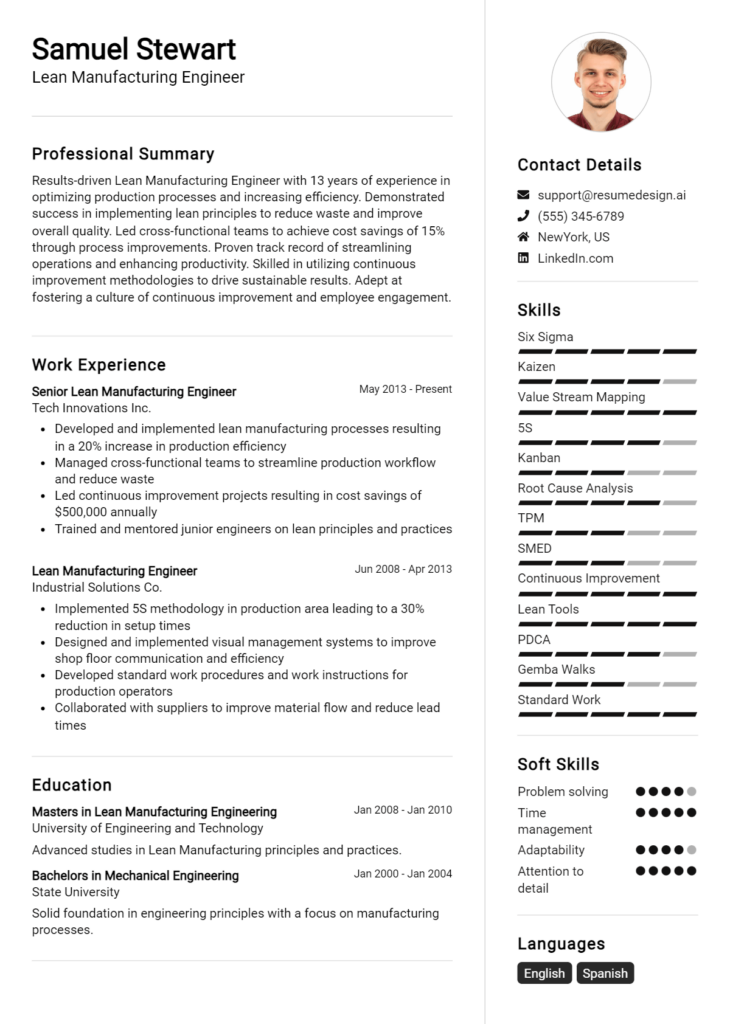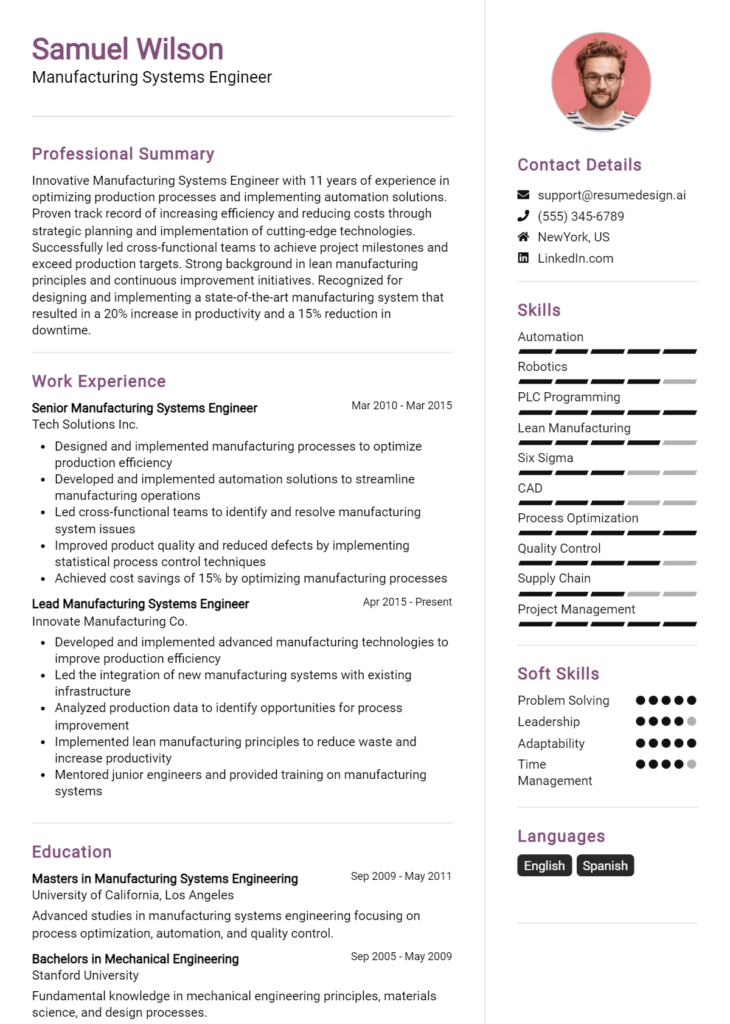Ergonomics Engineer Core Responsibilities
An Ergonomics Engineer plays a crucial role in enhancing workplace safety, productivity, and employee well-being by applying principles of ergonomics to design and improve work environments. Key responsibilities include assessing workflows, conducting ergonomic assessments, and collaborating with various departments such as HR, operations, and health and safety. Essential skills encompass technical knowledge, operational insight, and robust problem-solving abilities. A well-structured resume highlighting these qualifications can effectively demonstrate how the engineer contributes to organizational goals by fostering a healthier and more efficient workplace.
Common Responsibilities Listed on Ergonomics Engineer Resume
- Conduct ergonomic assessments and evaluations of workstations and tools.
- Design and recommend modifications to improve ergonomic practices.
- Collaborate with cross-functional teams to implement ergonomic solutions.
- Analyze data to identify risk factors related to musculoskeletal disorders.
- Develop training programs on ergonomic best practices for employees.
- Monitor and report on the effectiveness of ergonomic interventions.
- Stay updated on industry standards and regulations related to ergonomics.
- Facilitate workshops and seminars to promote ergonomic awareness.
- Conduct research to support evidence-based ergonomic improvements.
- Create ergonomic design guidelines for new products and processes.
- Provide recommendations for ergonomic equipment and tools.
- Assist in the development of workplace policies that prioritize ergonomics.
High-Level Resume Tips for Ergonomics Engineer Professionals
In the competitive field of ergonomics engineering, a well-crafted resume is not just a document; it is your first opportunity to make a lasting impression on potential employers. A strong resume should effectively showcase your unique skills, achievements, and experiences that set you apart from other candidates. It serves as a powerful marketing tool, reflecting your technical expertise and commitment to enhancing workplace safety and productivity. In this guide, we will provide practical and actionable resume tips specifically tailored for ergonomics engineer professionals, ensuring that your resume stands out in a crowded job market.
Top Resume Tips for Ergonomics Engineer Professionals
- Tailor your resume to each job description by incorporating relevant keywords and phrases that align with the specific role.
- Highlight your education and certifications in ergonomics, human factors, or related fields prominently to establish your qualifications.
- Showcase relevant experience by detailing specific projects you've worked on, emphasizing your role and contributions.
- Quantify your achievements by using metrics to illustrate the impact of your work, such as improved employee productivity or reduced injury rates.
- Include industry-specific skills, such as knowledge of ergonomic assessment tools, software proficiency, and familiarity with safety regulations.
- Utilize a clean and professional format that enhances readability, making it easy for hiring managers to quickly identify your key qualifications.
- Incorporate a summary statement at the beginning of your resume that encapsulates your expertise and career goals in ergonomics engineering.
- List any relevant professional memberships or affiliations that demonstrate your commitment to the field and ongoing professional development.
- Highlight soft skills, such as communication and teamwork, which are crucial in collaborating with diverse teams to implement ergonomic solutions.
By implementing these resume tips, ergonomics engineer professionals can significantly increase their chances of landing a job in this specialized field. A well-structured and tailored resume will not only showcase your qualifications but also reflect your understanding of the industry's demands, ultimately leading to more interview opportunities and career advancement.
Why Resume Headlines & Titles are Important for Ergonomics Engineer
In the highly specialized field of ergonomics engineering, a resume headline or title plays a crucial role in capturing the attention of hiring managers. A strong headline serves as the first impression of a candidate, summarizing their key qualifications and unique value proposition in just a few impactful words. This concise and relevant phrase should directly relate to the job being applied for, demonstrating the candidate's alignment with the role and their ability to contribute effectively. By crafting an effective resume headline, candidates can immediately communicate their expertise and stand out among a sea of applicants, increasing their chances of landing an interview.
Best Practices for Crafting Resume Headlines for Ergonomics Engineer
- Keep it concise: Aim for a headline that is no longer than one or two lines.
- Be role-specific: Tailor the headline to reflect the specific ergonomics engineering position you are applying for.
- Highlight key skills: Incorporate relevant technical skills or certifications that showcase your expertise.
- Use action-oriented language: Choose powerful verbs that convey a sense of proactivity and impact.
- Include measurable achievements: If possible, quantify your accomplishments to demonstrate your effectiveness.
- Stay relevant: Ensure the headline aligns closely with the job description and requirements.
- Avoid jargon: Use clear language that is easily understandable to all hiring managers.
- Emphasize unique value: Highlight what sets you apart from other candidates in the field.
Example Resume Headlines for Ergonomics Engineer
Strong Resume Headlines
"Certified Ergonomics Engineer with 5+ Years in Workplace Safety Innovations"
“Expert in Human Factors Engineering with Proven Track Record of Reducing Workplace Injuries”
“Dynamic Ergonomics Specialist Focused on Enhancing Employee Productivity and Comfort”
Weak Resume Headlines
“Engineering Professional Looking for Work”
“Resume of an Ergonomics Engineer”
Strong resume headlines are effective because they immediately convey a clear and compelling message about the candidate’s qualifications and contributions, piquing the interest of hiring managers. They reflect the candidate's specific skills and achievements in the ergonomics engineering field, making it easy for employers to see the potential value they could bring to their organization. Conversely, weak headlines fail to impress because they lack specificity and do not communicate any unique strengths or accomplishments. Vague titles like "Engineering Professional Looking for Work" do not provide any meaningful insight into the candidate’s expertise, making it difficult for hiring managers to evaluate their fit for the role.
Writing an Exceptional Ergonomics Engineer Resume Summary
A resume summary is critical for an Ergonomics Engineer as it serves as the first impression for hiring managers. This concise section quickly captures attention by showcasing key skills, relevant experience, and notable accomplishments that align with the specific demands of the job role. A well-crafted summary not only highlights your qualifications but also sets the tone for the rest of your resume, making it essential to be impactful and tailored to the position you are applying for.
Best Practices for Writing a Ergonomics Engineer Resume Summary
- Quantify achievements to demonstrate impact, such as improvements in workplace safety or efficiency.
- Focus on key skills relevant to ergonomics, including knowledge of ergonomic assessments and design principles.
- Tailor the summary to the job description, incorporating keywords that reflect the specific requirements of the role.
- Keep it concise, ideally between 3-5 sentences, to maintain the attention of hiring managers.
- Highlight any certifications or specialized training in ergonomics or related fields.
- Showcase your problem-solving skills and ability to implement ergonomic solutions effectively.
- Incorporate soft skills, such as communication and teamwork, that are essential for collaborating with cross-functional teams.
- Use strong action verbs to convey your contributions and accomplishments clearly.
Example Ergonomics Engineer Resume Summaries
Strong Resume Summaries
Dynamic Ergonomics Engineer with over 8 years of experience in reducing workplace injuries by 30% through comprehensive ergonomic assessments and tailored design solutions. Proven ability to collaborate with cross-functional teams to implement safety protocols and improve employee comfort, resulting in a 20% increase in productivity.
Results-oriented Ergonomics Engineer with a Master's degree in Industrial Engineering and certification in Human Factors. Successfully led a project that redesigned office layouts, leading to a 15% reduction in reported musculoskeletal disorders among employees. Expertise in conducting ergonomic evaluations and developing training programs for best practices.
Innovative Ergonomics Engineer with a track record of enhancing workplace ergonomics for leading manufacturing firms. Spearheaded a cross-departmental initiative that improved workstation designs, achieving a 25% decrease in worker compensation claims. Skilled in utilizing ergonomic principles to boost efficiency and employee wellbeing.
Weak Resume Summaries
Experienced engineer looking for an ergonomics position. I have worked in various fields and can help improve work environments.
Ergonomics Engineer with some experience in the industry. I am interested in contributing to projects and learning more about the field.
The examples of strong resume summaries are considered effective because they provide specific, quantifiable achievements and relevant skills that directly relate to the Ergonomics Engineer role. They highlight concrete outcomes that demonstrate the candidate's impact in previous positions. In contrast, the weak resume summaries lack detail, contain vague statements, and fail to showcase any measurable results or specific expertise, making them less impactful and memorable to hiring managers.
Work Experience Section for Ergonomics Engineer Resume
The work experience section of an Ergonomics Engineer resume is critical in establishing the candidate’s qualifications and suitability for the role. This section serves as a platform to showcase technical skills, project management capabilities, and the ability to deliver high-quality ergonomic solutions. By detailing specific experiences and quantifying achievements, candidates can effectively demonstrate their impact in previous roles. Aligning work experience with industry standards not only highlights proficiency in ergonomic principles but also illustrates a commitment to excellence in design and implementation.
Best Practices for Ergonomics Engineer Work Experience
- Clearly outline your role and responsibilities in each position.
- Use action verbs to describe your contributions and achievements.
- Quantify results using metrics such as improved efficiency or decreased injury rates.
- Highlight collaboration with cross-functional teams to illustrate teamwork skills.
- Focus on relevant projects that align with industry standards and best practices.
- Include certifications or training that enhance your expertise.
- Tailor your experiences to the specific job description, emphasizing relevant skills.
- Showcase problem-solving abilities and innovative approaches to ergonomic challenges.
Example Work Experiences for Ergonomics Engineer
Strong Experiences
- Led a team of 5 engineers to redesign workstations, resulting in a 30% reduction in reported musculoskeletal disorders over one year.
- Developed and implemented a comprehensive ergonomic training program that improved employee satisfaction scores by 25% and reduced workplace injuries.
- Conducted ergonomic assessments on 50+ work environments, providing actionable recommendations that increased productivity by an average of 15%.
- Collaborated with product design teams to integrate ergonomic principles into new product lines, resulting in a 20% increase in user satisfaction ratings.
Weak Experiences
- Worked on ergonomics projects.
- Helped out with team assessments.
- Participated in training sessions.
- Assisted in various ergonomic initiatives.
The examples provided illustrate a clear distinction between strong and weak experiences. Strong experiences are specific, quantifiable, and demonstrate a proactive role in achieving significant outcomes. They highlight leadership, collaboration, and measurable results, making them impactful. In contrast, weak experiences lack detail and fail to convey any significant contributions or achievements, making them less compelling to potential employers.
Education and Certifications Section for Ergonomics Engineer Resume
The education and certifications section of an Ergonomics Engineer resume plays a critical role in showcasing the candidate's academic foundation, specialized knowledge, and commitment to professional development. This section allows potential employers to assess the applicant's qualifications, highlighting relevant degrees, industry-recognized certifications, and any specialized training that underscores their expertise in ergonomics. By detailing relevant coursework and certifications, candidates can greatly enhance their credibility and demonstrate their alignment with the specific demands of the job role, making it a vital component of an effective resume.
Best Practices for Ergonomics Engineer Education and Certifications
- Prioritize degrees in ergonomics, human factors, industrial engineering, or related fields.
- Include industry-recognized certifications such as Certified Professional Ergonomist (CPE) or Board Certified Ergonomics Practitioner (BCEP).
- Detail relevant coursework that showcases specific skills or knowledge applicable to ergonomics.
- Highlight any specialized training or workshops that enhance your ergonomic expertise.
- Present a clear timeline of your education and certifications to demonstrate continuous learning.
- Use clear headings and bullet points for easy readability and emphasis on key qualifications.
- Include GPA or honors if they are particularly strong and relevant to the position.
- Tailor the education and certification details to align with the job description and requirements.
Example Education and Certifications for Ergonomics Engineer
Strong Examples
- Bachelor of Science in Human Factors Engineering, University of California, Berkeley, 2020
- Certified Professional Ergonomist (CPE), Board of Certification in Professional Ergonomics, 2021
- Master of Science in Industrial Engineering with a focus on Ergonomics, Georgia Institute of Technology, 2022
- Coursework in Advanced Ergonomics and Human Factors, University of Michigan, 2019
Weak Examples
- Bachelor of Arts in Psychology, University of Texas, 2010 (not directly related to ergonomics)
- Certification in Basic First Aid, 2018 (not relevant to ergonomics engineering)
- Master's degree in Business Administration, Harvard University, 2021 (not focused on ergonomics)
- Old certification in Office Safety, 2015 (outdated and not relevant to current ergonomics practices)
The strong examples are considered effective because they directly relate to the field of ergonomics and demonstrate a clear educational path and relevant certifications that align with industry standards. In contrast, the weak examples lack relevance to the ergonomics discipline and may not support the candidate's qualifications for the role, potentially raising questions about their suitability for the position.
Top Skills & Keywords for Ergonomics Engineer Resume
An Ergonomics Engineer plays a critical role in designing work environments and tools that enhance user comfort, efficiency, and safety. To stand out in this competitive field, a well-crafted resume should highlight both hard and soft skills that showcase a candidate's technical expertise and interpersonal abilities. Employers are looking for individuals who not only possess the relevant technical knowledge but also demonstrate effective communication, problem-solving, and teamwork skills. Therefore, it is essential to carefully select and present these skills in your resume to align with the job requirements and convey your suitability for the role.
Top Hard & Soft Skills for Ergonomics Engineer
Soft Skills
- Communication skills
- Problem-solving abilities
- Attention to detail
- Team collaboration
- Adaptability
- Critical thinking
- Creativity
- Time management
- Empathy
- Conflict resolution
Hard Skills
- Proficiency in ergonomic assessment tools
- Knowledge of human factors principles
- CAD software proficiency (e.g., AutoCAD, SolidWorks)
- Familiarity with industry standards (e.g., ISO, ANSI)
- Data analysis and interpretation
- Risk assessment techniques
- Knowledge of biomechanics
- Project management skills
- Understanding of workplace safety regulations
- Experience with user-centered design methodologies
For more insights on how to enhance your resume with skills and effectively showcase your work experience, consider exploring additional resources that can help refine your application.
Stand Out with a Winning Ergonomics Engineer Cover Letter
Dear [Hiring Manager's Name],
I am writing to express my interest in the Ergonomics Engineer position at [Company Name] as advertised on [Job Board/Company Website]. With a strong background in human factors engineering and a passion for designing user-centered solutions, I am excited about the opportunity to contribute to your team. My educational background in Industrial Engineering, combined with hands-on experience in ergonomic assessments and workplace design, positions me uniquely to enhance employee well-being and productivity at [Company Name].
In my previous role at [Previous Company Name], I successfully led ergonomic assessments across various departments, identifying risk factors and implementing solutions that resulted in a 30% reduction in workplace injuries. By collaborating closely with multidisciplinary teams, I developed training programs that educated employees on proper ergonomic practices and the importance of workstation optimization. My ability to analyze complex work environments and apply evidence-based ergonomic principles has consistently improved comfort and efficiency, leading to a more engaged workforce.
I am particularly impressed by [Company Name]'s commitment to employee wellness and innovation in the workplace. I believe that my skills in conducting ergonomic evaluations, coupled with my expertise in utilizing software tools for ergonomic analysis, will allow me to make a significant impact on your existing initiatives. I am eager to bring my proactive approach and problem-solving skills to your esteemed organization and help foster a culture of safety and productivity.
Thank you for considering my application. I look forward to the opportunity to discuss how my background and passion for ergonomics align with the goals of [Company Name]. I am excited about the prospect of working together to create a healthier and more efficient workplace.
Sincerely,
[Your Name]
[Your Phone Number]
[Your Email Address]
Common Mistakes to Avoid in a Ergonomics Engineer Resume
Crafting a resume as an Ergonomics Engineer requires attention to detail and a clear presentation of relevant skills and experiences. However, many candidates make common mistakes that can undermine their chances of landing an interview. Understanding these pitfalls can significantly enhance your resume's effectiveness and showcase your qualifications in the best light. Here are some mistakes to avoid:
Vague Job Descriptions: Failing to provide specific details about your previous roles can leave hiring managers unclear about your qualifications. Instead, use precise language to describe your responsibilities and achievements.
Ignoring Keywords: Many employers use Applicant Tracking Systems (ATS) to filter resumes. Not including relevant keywords from the job description can result in your resume being overlooked. Tailor your resume to match the terminology used in the job posting.
Lack of Quantifiable Achievements: Simply listing duties without quantifying accomplishments can weaken your resume. Highlight measurable impacts, such as “Improved workspace efficiency by 30% through ergonomic redesigns.”
Overly Technical Language: While technical knowledge is crucial, using excessive jargon can alienate non-technical hiring managers. Strive for a balance that showcases your expertise while remaining accessible.
Neglecting Soft Skills: Ergonomics Engineering often involves collaboration and communication. Failing to mention relevant soft skills like teamwork, problem-solving, and interpersonal communication can create an incomplete picture of your capabilities.
Ignoring Formatting: A cluttered or inconsistent format can detract from the content of your resume. Use clear headings, uniform font sizes, and bullet points to enhance readability and make sure your resume is visually appealing.
Not Including Continuing Education: The field of ergonomics is constantly evolving. Failing to mention any ongoing education, certifications, or training can suggest a lack of commitment to professional development.
Generic Objective Statements: Using a one-size-fits-all objective statement can make your resume blend in with others. Instead, tailor your objective to reflect your specific interest in the role and the value you bring to the organization.
Conclusion
As we wrap up our discussion on the vital role of an Ergonomics Engineer, it's essential to remember that the foundation of a successful career in this field starts with a strong resume. We explored the significance of integrating ergonomic principles into design, the necessity of staying updated with industry standards, and the importance of continuous learning and professional development.
Your resume should reflect not only your technical skills and experiences but also your understanding of human factors and how they apply to your work. Highlight any projects, certifications, or tools you've used that showcase your ability to enhance workplace safety and efficiency.
Now is the perfect time to take action and review your Ergonomics Engineer resume. Consider utilizing available resources to enhance your job application materials. Explore various resume templates to find a design that suits your style, or use a resume builder for a streamlined approach to creating a professional resume. If you're looking for inspiration, check out resume examples tailored for Ergonomics Engineers. Don't forget the importance of a compelling cover letter; browse our collection of cover letter templates to help you make a great first impression.
Take the time to refine your resume today and position yourself as a standout candidate in the competitive field of ergonomics engineering!

